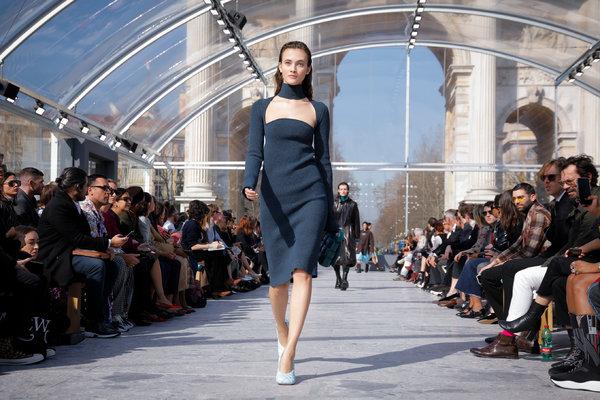
Bottega Veneta, fall 2019CreditValerio Mezzanotti for The New York Times
MILAN — When Phoebe Philo left Celine just before Christmas in 2017, an entire swath of female shoppers went into mourning. The designer who had given them a wardrobe that spoke to their minds and ambitions — that provided intelligent comfort without glitz, that swaddled in a most subtle way — was stepping down. When she was replaced by Hedi Slimane, fetishizer of the skinny suit and truncated hemline and dash of rock star desiccation, they despaired. Where would they shop?
Then Bottega Veneta, the Italian brand that had been defined for 17 years by Tomas Maier, the insistence that your own initials are enough and its woven intrecciato leather bags, announced that Mr. Maier would be leaving the company and would be replaced by Daniel Lee, a young British designer most people had never heard of. What they knew, however, was this: Mr. Lee’s previous job has been as the head of ready-to-wear at Celine under Ms. Philo.
Wait! Maybe more was going on than boring designer musical chairs.
Was Bottega going to reimagine itself as the brand for loyalists of what has become colloquially known as Old Celine? Were they going to have a new place to shop? Was Mr. Lee’s aesthetic also — maybe? — a Philo-phile aesthetic? If so, was that, in fact, a good thing or had its time come and gone (has it been idealized in retrospect)?
On Friday morning in Milan, as Mr. Lee unveiled his first runway collection for the brand, everyone got to find out.
And the answer is … a qualified yes.
Though clearly in the vernacular of Old Celine as well as the house he has just joined, Mr. Lee’s Bottega was tougher, cooler, less interested in tête-à-têtes in an arty corner, and less well-behaved than either past brand. That’s a good thing.
It was also, on occasion, overly tricky (especially when it came to quilted skirts that folded into an A-line shape at the sides and linked across the groin with a fancy chain) and sometimes too literal (full-body leather biker jackets and pants). But those are relatively little quibbles. Given the weight of expectations and Mr. Lee’s youth (he’s in his early 30s), it was an impressively confident and coherent debut.
A new geometric V was introduced as closures on coats and the flap shape of a pocket, and the aforementioned chain repeated as gold trim on deep round-necked sweaters, and in the form of leather links woven together into a new sort of intrecciato coat.
The neck was the erogenous zone, both in reference to Renaissance portraiture and because, Mr. Lee said after the show, “it’s a part of the body most people are comfortable exposing.” Jackets had their collars raised and the lapels wrenched open, the shoulder dropped just off the bone, to create a heart-shaped curve. There were mirrored shirt dresses (shirt dresses are a thing this season) layered atop each other, and two-tone knits twisted up and around and over. There was men’s wear in a similar mode.
“He’s not afraid of the heritage,” François-Henri Pinault, chief executive of Kering, the French group that owns Bottega, said of Mr. Lee before the show, and he was right. But as a designer, Mr. Lee is also mature enough not to reject the past out of hand. Instead, he had some fun moving it forward.
Even if afterward, with the stress of the reveal finally over, he looked a little played out.







